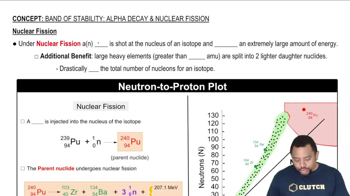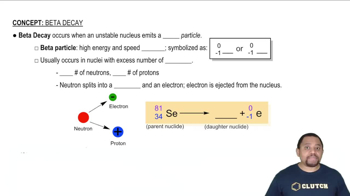Here are the essential concepts you must grasp in order to answer the question correctly.
Nuclear Fission
Nuclear fission is the process by which a heavy nucleus splits into two or more smaller nuclei, along with the release of energy and neutrons. This reaction is typically initiated by the absorption of a neutron by the nucleus. The released neutrons can then induce further fission events, leading to a chain reaction, which is the principle behind nuclear reactors.
Recommended video:
Band of Stability: Nuclear Fission
Radioactive Decay
Radioactive decay is the process by which an unstable atomic nucleus loses energy by emitting radiation. This can occur through various modes, including alpha decay, beta decay, and gamma decay. The type of decay that predominates depends on the neutron-to-proton ratio of the nucleus, with heavy nuclei often undergoing alpha decay to achieve stability.
Recommended video:
Rate of Radioactive Decay
Decay Chains
Decay chains refer to a series of radioactive decays that occur as unstable isotopes transform into more stable forms. Each step in the chain involves the emission of particles or radiation, leading to different isotopes until a stable isotope is reached. In the context of fission products, these chains can result in a variety of decay products, often including isotopes of lead, bismuth, and polonium.
Recommended video:


 Verified step by step guidance
Verified step by step guidance


